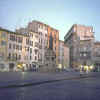-
- Before the 15th century it was a camp covered by
green grass and flowers, which was used as a pasture land. This probably
gave the name to the square: Campo di Flora. It became an important place
due to the transfer of the traffic from the slopes of the Capitoline Hill to
the new city which grew in direction to the new residence in Vatican after
return of popes from Avignon. Since the 12th century the zone was dominated
by the Orsini family, which possessed houses and towers erected on the place
of so called "trullo", i.e. ruins of Teatro di Pompeo.
- According to the order of Eugenius IV the square was
paved in 1440, and the other works were executed in the end of the century,
when the first fountain was built here and substituted a hundred years later
by Gregory XIII by a famous "terrina" (tureen), which is now
located in front of Chiesa Nuova.
- The square was a site of market, hotels, inns,
book-shops and houses of famous courtesans. As one of the city centers here
the executions took place as well. In 1600 Giordano Bruno was burnt in this
square as a heretic, by the Inquisition, to who was erected a simple
monument in 1889, by Ettore Ferrari.
- In the end of past century Campo dei Fiori was
enlarged due to demolition on the side where the present fountain stands.
This is also a site of a daily market with a big section of flower-vendors
and a center of a distinctive district of the city, with numerous artisans'
workshops.
|
